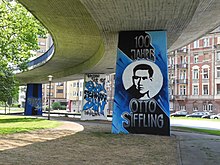Otto Siffling
| Otto Siffling | ||
| Personnel | ||
|---|---|---|
| birthday | August 3, 1912 | |
| place of birth | Mannheim , German Empire | |
| date of death | October 20, 1939 | |
| size | 176 cm | |
| position | attack | |
| Juniors | ||
| Years | station | |
| -1930 | SV Waldhof Mannheim | |
| Men's | ||
| Years | station | Games (goals) 1 |
| 1930-1938 | SV Waldhof Mannheim | |
| National team | ||
| Years | selection | Games (goals) |
| 1934-1938 | Germany | 31 (17) |
| 1 Only league games are given. | ||
Otto "wood" Siffling (born August 3, 1912 in Mannheim - Waldhof , † October 20, 1939 ) was a German football player . He played for SV Waldhof Mannheim and the German national team , with which he won the bronze medal at the World Cup in 1934. In 1937 he scored five goals in an international match, making him third among the national team with the most goals in a game .
Life
Otto Siffling came from a Mannheim footballer family. His brothers Heinrich and Oskar and his cousin Ludwig Siffling were all active players in the 1930s.
Siffling's home club was SV Waldhof Mannheim . He joined him as a student and was named to the first team at the age of 18. With Waldhof he was from 1931 to 1934 and 1936 and 1937 first in the Rhine district and the Gauliga Baden, at that time the highest league in German football, and thus qualified for the fight for the German championship. The greatest success came in the 1933/34 season when the team advanced to the semi-finals and was eliminated from the eventual German champions FC Schalke 04 . In the cup , SV Waldhof was even able to reach the semi-finals twice with Siffling. In 1935 and 1937 , the club failed because of the later cup winners 1. FC Nürnberg and FC Schalke 04.
He was one of the first players in the club to be called up to the national team (there were handball national players from this club before). Siffling played 31 games for the German national soccer team from 1934 to 1938, scoring 17 goals. His greatest achievement was third place at the World Cup in Italy . The then coach of the national team, Otto Nerz , used him in the DFB-Elf's opening game against Belgium on May 27, 1934. The German team won the game 5-2. Siffling scored once and was used in all subsequent World Cup games against Sweden, Czechoslovakia and Austria. At the Olympic Games in 1936 Siffling was spared in the first game and then used in the quarter-finals, where Germany, however, was eliminated against Norway.
With his ten goals, which he scored in the international matches of 1937, he was one of the players who had the greatest share in the fame of the Breslau-Elf , who won 8-0 against Denmark in Breslau . Siffling scored five goals within 32 minutes, making him third among the national team with the most goals in a game . An essential tactical variant was the position and task of Otto Siffling in the middle of the storm. He did not play as a forward "wedge striker" in the middle of the attack, but hung back, luring the opposing stopper out of the defense center and distributing the balls to the fast wings. The torn cover of the Danes enabled him to come to an end himself.
Otto Siffling died at the age of 27 in 1939 at a pleurisy . He played his last international match on April 24, 1938 in Frankfurt am Main in a 1-1 draw against Portugal . Siffling is still the SV Waldhof Mannheim player with the most appointments for the national team.
In 1977 his hometown Mannheim named a street in the Waldhof district after him. On his hundredth birthday, the east grandstand in the Carl Benz stadium was named after Siffling and a memorial plaque was unveiled on the house where he was born in Hubenstrasse.
literature
- Double pass - SV Waldhof Mannheim fans against violence and racism e. V. (Ed.): Otto Siffling - A football legend turns 100 . Catalog for the exhibition in Mannheim from June 1 to 13, 2012 in the Alte Feuerwache Mannheim, Berlin 2012, ISBN 978-3-00-038249-9 .
- Jürgen Bitter : Germany's national soccer player: the lexicon . SVB Sportverlag, Berlin 1997, ISBN 3-328-00749-0 .
- Richard Kirn, Alex Natan: Soccer. Ullstein-TB-Verlag, Frankfurt am Main 1958.
- Karl-Heinz Schwarz-Pich: Otto Siffling, SV Waldhof and the German national soccer team in the Third Reich. Agon-Sportverlag, Kassel 1999, ISBN 3-89784-101-0 .
Web links
- Otto Siffling in the database of weltfussball.de
- Otto Siffling in the database of transfermarkt.de
- Literature by and about Otto Siffling in the catalog of the German National Library
- "Otto Siffling - A football legend turns 100" (otto-siffling.de)
- Article about Otto Siffling in the SV Waldhof Wiki
Individual evidence
- ↑ MARCHIVUM: street names, Otto Siffling Street. Retrieved August 27, 2018 .
- ^ Mannheimer Morgen: Modest top athlete. July 3, 2012, accessed August 25, 2013 .
- ↑ Mannheimer Morgen: Memorial plaque on the birthplace of Otto Siffling. August 3, 2012, accessed August 25, 2013 .
| personal data | |
|---|---|
| SURNAME | Siffling, Otto |
| ALTERNATIVE NAMES | Siffling, wood (nickname) |
| BRIEF DESCRIPTION | German soccer player |
| DATE OF BIRTH | August 3, 1912 |
| PLACE OF BIRTH | Mannheim - Waldhof , German Empire |
| DATE OF DEATH | October 20, 1939 |

